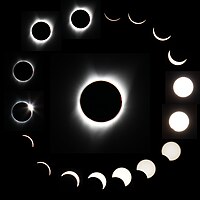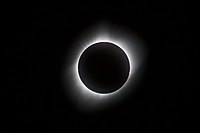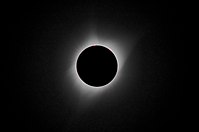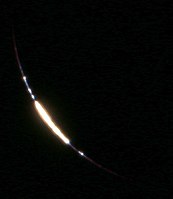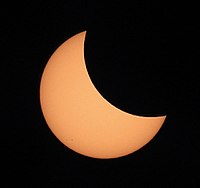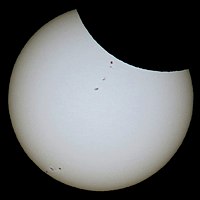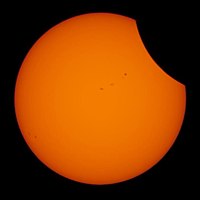Solar eclipse of August 21, 2017
| Solar eclipse of August 21, 2017 | |
|---|---|
 Totality from Madras, Oregon | |
| Type of eclipse | |
| Nature | Total |
| Gamma | 0.4367 |
| Magnitude | 1.0306 |
| Maximum eclipse | |
| Duration | 160 s (2 min 40 s) |
| Coordinates | 37°00′N 87°42′W / 37°N 87.7°W |
| Max. width of band | 115 km (71 mi) |
| Times (UTC) | |
| (P1) Partial begin | 15:46:48 |
| (U1) Total begin | 16:48:32 |
| Greatest eclipse | 18:26:40 |
| (U4) Total end | 20:01:35 |
| (P4) Partial end | 21:04:19 |
| References | |
| Saros | 145 (22 of 77) |
| Catalog # (SE5000) | 9546 |
The solar eclipse of August 21, 2017, dubbed the "Great American Eclipse" by some media,[1] was a total solar eclipse visible within a band that spanned the contiguous United States from the Pacific to the Atlantic coasts. It was also visible as a partial solar eclipse from as far north as Nunavut in northern Canada to as far south as northern South America. In northwestern Europe and Africa, it was partially visible in the late evening. In northeastern Asia, it was partially visible at sunrise.
Prior to this event, no solar eclipse had been visible across the entirety of the United States since June 8, 1918; not since the February 1979 eclipse had a total eclipse been visible from anywhere in the mainland United States.[2] The path of totality touched 14 states, and the rest of the U.S. had a partial eclipse.[2] The area of the path of totality was about 16 percent of the area of the United States,[3] with most of this area over the ocean, not land. The event's shadow began to cover land on the Oregon coast as a partial eclipse at 4:05 p.m. UTC (9:05 a.m. PDT), with the total eclipse beginning there at 5:16 p.m. UTC (10:16 a.m. PDT); the total eclipse's land coverage ended along the South Carolina coast at about 6:44 p.m. UTC (2:44 p.m. EDT).[2] Visibility as a partial eclipse in Honolulu, Hawaii began with sunrise at 4:20 p.m. UTC (6:20 a.m. HST) and ended by 5:25 p.m. UTC (7:25 a.m. HST).[4]
This total solar eclipse marked the first such event in the smartphone and social media era in the United States. Information, personal communication, and photography were widely available as never before, capturing popular attention and enhancing the social experience. The event was received with much enthusiasm across the nation; people gathered outside their homes to watch it, and many parties were set up in the path of the eclipse. Many people left their homes and traveled hundreds of miles just to get a glimpse of totality, which few ever get to experience. Marriage proposals were timed to coincide with the eclipse, as was at least one wedding.[5][6] Logistical problems arose with the influx of visitors, especially for smaller communities.[7] The sale of counterfeit eclipse glasses was also anticipated to be a hazard for eye injuries.[8]
The next solar eclipse that crossed the United States occurred on April 8, 2024 (12 states). Future solar eclipses that cross the United States will occur on August 23, 2044 (3 states), and on August 12, 2045 (10 states). Annular solar eclipses—wherein the Moon appears smaller than the Sun—occurred in October 2023 (9 states) and will occur in June 2048 (9 states).
Visibility
The total eclipse occurred at the Moon's ascending node of orbit and had a magnitude of 1.0306. Occurring about 3.2 days after perigee (on August 18, 2017, at 14:20 UTC), the Moon's apparent diameter was larger during this eclipse.[9] It was visible within a narrow corridor 70 miles (110 km) wide, crossing 14 of the contiguous United States: Oregon, Idaho, Montana, Wyoming, Nebraska, Kansas, Iowa, Missouri, Illinois, Kentucky, Tennessee, Georgia, North Carolina, and South Carolina.[10][11] It was first seen from land in the U.S. shortly after 10:15 am PDT (17:15 UTC) at Oregon's Pacific coast, and then it progressed eastward through Salem, Oregon; Idaho Falls, Idaho; Casper, Wyoming; Lincoln, Nebraska; Kansas City, Missouri; St. Louis, Missouri; Hopkinsville, Kentucky; and Nashville, Tennessee; before reaching Columbia, South Carolina about 2:41 pm;[12] and finally Charleston, South Carolina. A partial eclipse was seen for a greater time period, beginning shortly after 9:00 am PDT along the Pacific Coast of Oregon. Weather forecasts predicted clear skies in Western U.S. and some Eastern states, but clouds in the Midwest and East Coast.[13]
 |
 |
The longest ground duration of totality was 2 minutes 41.6 seconds at about 37°35′0″N 89°7′0″W / 37.58333°N 89.11667°W in Giant City State Park, just south of Carbondale, Illinois, and the greatest extent (width) was at 36°58′0″N 87°40′18″W / 36.96667°N 87.67167°W near the village of Cerulean, Kentucky, located in between Hopkinsville and Princeton.[14] This was the first total solar eclipse visible from the Southeastern United States since the solar eclipse of March 7, 1970. Two NASA WB-57Fs flew above the clouds, prolonging the observation time spent in the umbra.[15] A partial solar eclipse was seen from the much broader path of the Moon's penumbra, including all of North America, particularly areas just south of the totality pass, where the eclipse lasted about 3–5 hours, Hawaii, Central America, the Caribbean, northern South America, Western Europe, and some of West Africa and Northeast Asia.
At one location in Wyoming, a small group of astronomers used telescopic lenses to photograph the sun as it was in partial eclipse, while the International Space Station was also seen to briefly transit the sun.[16] Similar images were captured by NASA from a location in Washington. (See Gallery – partial eclipse section).
List of municipalities in the path of totality
Other celestial bodies
 |
 |
During the eclipse for a long span of its path of totality, several bright stars and four planets were visible. The star system Regulus was almost in conjunction with the Sun. Mars was 8° to the right, and Venus 34° right. Mercury was 10° left, and Jupiter 51° left.[18]
Other eclipses over the United States
This was the first total solar eclipse visible from the United States since that of July 11, 1991[19]—which was seen only from part of Hawaii[20]—and the first visible from the contiguous United States since 1979.[21] An eclipse of comparable length (up to 3 minutes, 8 seconds, with the longest eclipse being 6 minutes and 54 seconds) occurred over the contiguous United States on March 7, 1970 along the southern portions of the Eastern Seaboard, from Florida to Virginia.[22]
The path of totality of the solar eclipse of February 26, 1979 crossed only the states of Washington, Oregon, Idaho, Montana, and North Dakota. Many enthusiasts traveled to the Pacific Northwest to view the eclipse, since it would be the last chance to view such an eclipse in the contiguous United States for almost four decades.[23][24]

The August 2017 eclipse was the first with a path of totality crossing the Pacific and Atlantic coasts of the U.S. since the solar eclipse of 1918. Also, its path of totality made landfall exclusively within the United States, making it the first such eclipse since the country's declaration of independence in 1776. Prior to this, the path of totality of the eclipse of June 13, 1257, was the last to make landfall exclusively on lands currently part of the United States.[25]
The path of the solar eclipse of April 8, 2024 crossed the path of the 2017 eclipse, with the intersection in southern Illinois in Makanda Township at Cedar Lake, just south of Carbondale. An area of about 9,000 square miles (23,000 km2), including the cities of Makanda, Carbondale, Cape Girardeau, Missouri, and Paducah, Kentucky, will thus experience two total solar eclipses within a span of less than seven years.[26]
The solar eclipse of August 12, 2045, will have a very similar path of totality over the U.S. to the 2017 eclipse: about 400 km (250 mi) to the southwest, also crossing the Pacific and Atlantic coasts of the country; however, totality will be more than twice as long, and it will be seen not only in the United States. It will be seen in the Americas.[27]
Total eclipse viewing events
Oregon



- Corvallis – The Corvallis campus of Oregon State University hosted "OSU150 Space Grant Festival: A Total Eclipse Experience", a weekend-long celebration of the eclipse. A watch party was also hosted on campus the day of the eclipse.[28]
- Huntington – Historic Farewell Bend State Recreation Area hosted the RASC: Yukon Centre (Yukon Astronomical Society) and the RASC: Okanagan Centre. Solar viewing and presentations on the eclipse were given along with a dark-sky presentation.[29]
- Keizer – The Salem-Keizer Volcanoes, a Class A baseball team, played a morning game against the visiting Hillsboro Hops that featured the first ever "eclipse delay" in baseball history.[30]
- Madras – The city sponsored a four-day Solarfest at two locations.[31]
- Ontario – Treasure Valley Community College hosted an eclipse viewing event.[32]
- Prineville – Symbiosis Gathering hosted a seven-day eclipse festival which included rave-style music dubbed "Oregon Eclipse".[33][34][35]
- Rickreall – The Polk County Fairgrounds organized a series of events and an eclipse gathering.[36]
- Salem – The Oregon Museum of Science and Industry hosted an event at the Oregon State Fairgrounds.[37]
Idaho


- Arco – High altitude balloon launches by the USC Astronautical Engineering department and NASA.[38]
- Craters of the Moon – The National Monument and Preserve hosted NASA presentations, evening star parties hosted by the Idaho Falls Astronomical Society, and presentations by the New Mexico Chapter of the Charlie Bates Solar Astronomy Project.[38]
- Idaho Falls – Free entertainment and educational seminars and an eclipse-watching event at the Museum of Idaho (an official NASA viewing site) and elsewhere, and a free eclipse-watching event at Melaleuca Field.[39][40]
- Rexburg – Brigham Young University Idaho offered a series of eclipse-related educational events.[41]
- Weiser – The city sponsored a five-day festival prior to the eclipse.[42]
Wyoming

- Crowheart – The YouTube channel Smarter Every Day, collaborating with photographer Trevor Mahlmann, observed and captured a simultaneous transit of the International Space Station during the partial phase of the eclipse.[43]
- Casper – The Astronomical League, an alliance of amateur astronomy clubs, held its annual Astrocon conference,[44] and there were other public events, called Wyoming Eclipse Festival 2017.[45]
- Fort Laramie – Fort Laramie held an eclipse viewing event, which included a Special "Great American Eclipse" Program.[46]
- Riverton – The biggest Polish expedition conducted as the Great Expedition of Polish Society of Amateur Astronomers was flocked between Riverton and Shoshoni in the central line of totality.[47]
Nebraska

- Alliance – Entertainment and educational seminars were offered.[48] ABC News reported live from Carhenge during totality.[49]
- Auburn – Nemaha County Hospital hosted an eclipse viewing event, including sharing safety tips from Lifetime Vision Center.[50]
- Beatrice – Homestead National Monument of America – Events were held with Bill Nye the Science Guy as well as representatives from NASA on Saturday, Sunday and the day of the eclipse.[51][52]
- Grand Island – Stuhr Museum hosted an eclipse viewing event, including the launch of a NASA eclipse observing balloon.[53]
- Lincoln – At Haymarket Park, the Lincoln Saltdogs, an independent baseball team in the American Association, defeated the Gary SouthShore RailCats 8–5 in a special eclipse game, with 6,956 in attendance. The game was paused for 26 minutes in the middle of the third inning to observe the eclipse. The Saltdogs players wore special eclipse-themed uniforms that were auctioned off after the game.[54][52]
Kansas
- Atchison – Benedictine College hosted thousands in its football stadium. There were students from schools from Kansas, Missouri, Nebraska, and Oklahoma attending, plus numerous other guests who heard from, amongst others, astronomers from the Vatican Observatory.[55]
Missouri
- Columbia – The Cosmo Park and the Gans Creek Park were open for the eclipse.[56] There was a watch party on campus for the students at the University of Missouri coordinated by Angela Speck,[57] and the MU Health Care system released eye safety information.[58]
- Kansas City – A 5-mile (8 km) bicycle ride from downtown KCMO (where totality only lasted about 30 seconds) to Macken Park in North Kansas City (where totality lasted 1 minute 13 seconds) was organized by KC Pedal Party Club, a local Meetup group.[59]
- Lathrop – The city celebrated its 150th anniversary with an eclipse festival.[60]
- Parkville – TotalEclipseofthePark – August 20 educational program featuring NASA Glenn Research Center Hall of Famer Lynn Bondurant, '61, and August 21 watch party organized by Park University.[61]
- Potosi – Hora Eclipse, an Israeli folkdance camp coordinated with the eclipse, was held at YMCA Trout Lodge and Camp Lakewood, near the Mark Twain National Forest. More information at the event's website, especially its post-mortem page.
- St. Clair – An event organized by the St. Clair City Chamber of Commerce.[62]
- St. Joseph – An event organized by Front Page Science was held at Rosecrans Memorial Airport.[63]
- St. Louis – David Tipper hosted his Tipper & Friends 4321 electronic music event at Astral Valley Art Park featuring 5 days of music, art, and eclipse viewing.[64]
Illinois

- Carbondale – Southern Illinois University sponsored many eclipse related educational events, including the two day Crossroads Astronomy, Science and Technology Expo, and viewing at Saluki Stadium.[65] Amtrak ran a special train, the Eclipse Express, from Chicago to Carbondale.[66] NASA EDGE was broadcasting live from Southern Illinois University Carbondale with a four-hour and thirty-minute show (11:45 a.m. – 4:15 p.m. EDT).[67]
- Carterville – A three-day rock festival called Moonstock was headlined by Ozzy Osbourne, who performed during the eclipse.[68]
- Goreville – The University of Illinois Astronomy Department hosted a viewing event in town, which was the closest village to the point of longest duration.[69]
Kentucky

- Bowling Green – Western Kentucky University hosted thousands of K-12 students in its football stadium.[70] At Bowling Green Ballpark, the Bowling Green Hot Rods, a Class A baseball team, played an eclipse game against the visiting West Michigan Whitecaps.[71]
- Hopkinsville – A four-day eclipse festival was held at Jefferson Davis State Historic Site.[72]
Tennessee

- Athens – The City of Athens hosted "Total Eclipse of the Park" at Athens Regional Park, including entertainment, food, and vendors.[73]
- Clarksville – Austin Peay State University presented several educational events, including an appearance by astronaut Rhea Seddon.[74]
- Cookeville – Tennessee Tech hosted a solar eclipse viewing party at Tucker Stadium.[6] Cookeville hosted special events from Saturday to Monday.
- McMinnville – celebrated the eclipse by hosting BLACKOUT 2017, an eclipse viewing event held in the city square. In addition to the viewing, a selection of food trucks and musical acts which features The Pink Floyd Appreciation Society band who performed Pink Floyd's The Dark Side of the Moon in its entirety prior to the totality event.[75]
- Memphis – At AutoZone Park, the Memphis Redbirds, a Class AAA baseball team, played an eclipse game against the visiting New Orleans Baby Cakes.[71]
- Nashville – offered many special events, including the Music City Eclipse Science & Technology Festival at the Adventure Science Center.[76] The Italian Lights Festival hosted the largest Eclipse Viewing Party in Nashville, a free NASA-Certified Eclipse Event held at the Bicentennial Mall.[77] Two astrophysicists from NASA's Jet Propulsion Laboratory emceed the countdown.[78]
North Carolina
- Bryson City – Planetarium shows were offered, as well as rides on the Great Smoky Mountains Railroad to an eclipse location.[79]
- Cullowhee – The eclipse was visible in totality, and classes were cancelled for several hours during the first day of classes at Western Carolina University.[80]
- Rosman – Pisgah Astronomical Research Institute (PARI) hosted a viewing event. The event at PARI has garnered international attention and the visitors included amateur astronomers.
Georgia
- Athens – Viewing at Sanford Stadium at the University of Georgia.[81]
- Blairsville – Get off the Grid Festival[82] on three days preceding the eclipse.
- Elbert County – Approximately 400 people gathered at the Georgia Guidestones.[83]
South Carolina
- Anderson – Viewing at the Green Pond Landing on Lake Hartwell with food trucks, astronomer, and music. Clouds blocked the sun at the beginning of totality, but almost completely disappeared throughout.
- Charleston – The College of Charleston hosted NASA's "eclipse headquarters" broadcast as part of an afternoon eclipse viewing celebration on the green behind the campus library.[84]
- Clemson – Viewing at Clemson University.[85]
- Columbia – The South Carolina State Museum hosted four days of educational events, including an appearance by Apollo 16 astronaut Charles Duke.[86] At Spirit Communications Park, the Columbia Fireflies, a Class A baseball team, played an eclipse game against the visiting Rome Braves.[71]
- Greenville – Viewing at Furman University. Events include streaming coverage from NASA, educational activities, and live music.[87] At Fluor Field, the Greenville Drive, a Class A baseball team, played an eclipse game against the visiting West Virginia Power.[71]
- Sumter – Viewing at Dillon Park. Eclipse viewing glasses given away for free.[88]
- Goose Creek – The clouds blocked the Eclipse that day much like in Anderson.
Viewing from outside the United States
Canada
A partial eclipse was visible across the width of Canada, ranging from 89 percent in Victoria, British Columbia to 11 percent in Resolute, Nunavut.[89] In Ottawa, viewing parties were held at the Canada Aviation and Space Museum.[90] In Toronto, viewing parties were held at the CNE and the Ontario Science Centre.[91]
Mexico, Central America, Caribbean islands, South America
A partial eclipse was visible from Central America, Mexico, the Caribbean islands, and ships and aircraft in and above the adjacent oceans,[92] as well as the northern countries of South America such as Colombia, Venezuela, and several others.[10]
On the Caribbean Sea, Bonnie Tyler performed her 1983 song "Total Eclipse of the Heart" live with the pop group DNCE on board the cruise ship Oasis of the Seas, as the ship entered the eclipse's totality path, east of The Bahamas.[93][94]
Europe

In northwestern Europe, a partial eclipse was visible in the evening or at sunset. Only those in Iceland, Ireland, Scotland and the Portuguese Azores archipelago saw the eclipse from beginning to end; in Wales, England, Norway, the Netherlands, Belgium, France, Spain, and Portugal, sunset occurred before the end of the eclipse. In Germany, the beginning of the eclipse was visible just at sunset only in the extreme northwest of the country. In all regions east of the orange line on the map, the eclipse was not visible.[95]
Asian Russia
A partial eclipse was visible during sunrise or morning hours in Russian Far East (including Severnaya Zemlya and New Siberian Islands archipelagos).[96][97] For big cities in Russia, the maximal obscuration was in Anadyr, and it was 27.82%.[98]
West Africa
In some locations in West Africa and western North Africa, a partial eclipse was seen just before and during sunset.[10] The most favorable conditions to see this eclipse gained the Cape Verde Archipelago with nearly 0.9 magnitude at the Pico del Fogo volcano.
Media and scientific coverage

A large number of media outlets broadcast coverage of the eclipse, including television and internet outlets. NASA announced plans to offer streaming coverage through its NASA TV and NASA Edge outlets, using cameras stationed on the ground along the path of totality, along with cameras on high-altitude balloons, jets, and coverage from the International Space Station; NASA stated that "never before will a celestial event be viewed by so many and explored from so many vantage points—from space, from the air, and from the ground."[99] ABC, CBS, and NBC announced that they would respectively broadcast live television specials to cover the eclipse with correspondents stationed across the path of totality, along with CNN, Fox News Channel, Science, and The Weather Channel. The PBS series Nova presented streaming coverage on Facebook hosted by Miles O'Brien, and aired a special episode chronicling the event—"Eclipse Over America"—later in the day (which marked the fastest production turnaround time in Nova history).[100][101]
Other institutions and services also announced plans to stream their perspectives of the eclipse, including the Exploratorium in San Francisco, the Elephant Sanctuary of Hohenwald, Tennessee, the Slooh robotic telescope app, and The Virtual Telescope Project. The Eclipse Ballooning Project, a consortium of schools and colleges that sent 50 high-altitude balloons into the sky during the eclipse to conduct experiments, provided streams of footage and GPS tracking of its launches.[99][102] Contact with one balloon with $13,000 of scientific equipment, launched under the aegis of the LGF Museum of Natural History near Vale, Oregon, was lost at 20,000 feet (6,100 m). Given that the balloon was believed to have burst at 100,000 feet (30,000 m), it could have parachuted down anywhere from eastern Oregon to Caldwell, Idaho (most likely) to Sun Valley, Idaho; a $1,000 reward is offered for its recovery.[103]
The National Solar Observatory organized Citizen CATE volunteers to man 60 identical telescopes and instrumentation packages along the totality path to study changes in the corona over the duration of the eclipse.
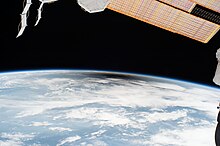
In orbit, the International Space Station and the satellites Lunar Reconnaissance Orbiter, Solar Dynamics Observatory, Moderate Resolution Imaging Spectroradiometer, Solar and Heliospheric Observatory, and Hinode gathered data from the eclipse.[104]
A viewing party was held at the White House, during which President Donald Trump appeared on the Truman Balcony with First Lady Melania Trump. With the Sun partially eclipsed, President Trump looked briefly in the general direction of the Sun before using solar viewing glasses.[105] Late-night comedians Trevor Noah and Conan O’Brien joked about Trump not wearing glasses,[106][107] and The Independent described it as "perhaps one of the most enduring images of Donald Trump's presidency".[108]
The eclipse generated reports of abnormal behavior in animal and plant life. Some chickens came out from beneath their coops and began grooming, usually an evening activity. Horses displayed increased whinnying, running, and jumping after the event. Cicadas were reported to grow louder before going silent during totality. Various birds were also observed flying in unusually large formations. Flowers such as the Hibiscus closed their petals which typically happens at night, before opening again after the solar event.[109]
Pornhub, a pornographic video-sharing website provided an unusual sociological and statistical report: its traffic dropped precipitously along the path of totality, so much so that its researchers were themselves surprised.[110]
NASA reported over 90 million page views of the eclipse on its websites, making it the agency's biggest online event ever, beating the previous web traffic record about seven times over.[111]
Counterfeit eclipse glasses

In the months leading up to the eclipse, many counterfeit glasses were put up for sale. Effective eclipse glasses must not only block most visible light, but most UV and infrared light as well. For visible light, the user should only be able to see the Sun, sunlight reflected off shiny metal, halogen bulbs, the filament in unfrosted incandescent bulbs, and similarly intense sources. Determining whether the glasses effectively block enough UV and infrared light requires the use of spectrophotometer, which is a rather expensive piece of lab equipment.[8][112]
The eye's retina lacks pain receptors, and thus damage can occur without one's awareness.[113][114]
The American Astronomical Society (AAS) said products meeting the ISO 12312-2 standard avoid risk to one's eyes and issued a list of reputable vendors of eclipse glasses. The organization warned against products claiming ISO certification or even citing the same number, but not tested by an accredited laboratory. Another problem was counterfeits of reputable vendors' products, some even claiming the company's name such as with American Paper Optics which published information detailing the differences between its glasses and counterfeits.[115][113]
Andrew Lund, the owner of a company which produces eclipse glasses, noted that not all counterfeit glasses were necessarily unsafe. He stated to Quartz that the counterfeits he tested blocked the majority of harmful light spectrum, concluding that "the IP is getting ripped off, but the good news is there are no long-term harmful effects."[112] As one example, the Springdale Library in metropolitan Pittsburgh, Pennsylvania, accidentally passed out dozens of pairs of counterfeit eclipse glasses, but as of August 23 had not received any reports of eye damage.[116]
On July 27, 2017, Amazon required all eclipse viewing products sold on its website have a submission of origin and safety information, and proof of an accredited ISO certification. In mid-August 2017, Amazon recalled and pulled listings for eclipse viewing glasses that "may not comply with industry standards" and gave refunds to customers who had purchased them.[117][8]
Camera equipment damage
Lensrentals, a camera rental company based in Tennessee, reported that many of its customers returned cameras and lenses with extensive damage. The most common problem reported was damage to the camera's sensor. This most often happens when shooting in live view mode, where the sensor is continuously exposed to the eclipse image and becomes damaged by the Sun's light. Another problem was the heat and brightness of the eclipse destroying the lens iris, which mechanically regulates the amount of light that enters the camera. Another problem reported was one of a cinema camera's neutral-density filter being damaged by the heat and light of the eclipse. The cost of all of this damage likely amounted to thousands of dollars.[118]
Planning

Officials inside and near the path of totality planned – sometimes for years – for the sudden influx of people.[119] Smaller towns struggled to arrange viewing sites and logistics for what could have been a tourism boom or a disaster.[120]
In the American West, illegal camping was a major concern, including near cities like Jackson Hole, Wyoming.[7] Idaho's Office of Emergency Management said Idaho was a prime viewing state, and advised jurisdictions to prepare for service load increases; nearly every hotel and motel room, campground, and in some cases backyards for nearly 100 miles (160 km) north and south of the path of totality had been reserved several months, if not years, in advance.[121] The state anticipated up to 500,000 visitors to join its 1.6 million residents.[122]
Oregon deployed six National Guard aircraft and 150 soldiers because the influx of visitors coincided with the state's fire season.[123] Hospital staffing, and supplies of blood and anti–snake bite antidote, were augmented along the totality line.[124]
Also in Oregon, there were reports of hoteliers canceling existing reservations made at the regular market rate and increasing their rate, sometimes threefold or more, for guests staying to view the eclipse.[125] The Oregon Department of Justice (DOJ) investigated various complaints and reached settlements with affected customers of at least 10 hotels in the state.[126] These settlements included refunds to the customers and fines paid to the DOJ.[127]
Post-eclipse traffic problems
Although traffic to areas within the path of totality was somewhat spread out over the days prior to the eclipse,[128] there were widespread traffic problems across the United States after the event ended. Michael Zeiler, an eclipse cartographer, had estimated that between 1.85 million and 7.4 million people would travel to the path of the eclipse.[129]
In Oregon, because an estimated one million people were expected to arrive, the Oregon National Guard was called in to help manage traffic in Madras along US 26 and US 97.[130] Madras Municipal Airport received more than 400 mostly personal planes that queued for hours while waiting to leave after the eclipse.[131]
Officials in Idaho, where the totality path crossed the center of the state, began planning for the eclipse a year in advance. The state Transportation Department suspended construction projects along Interstate 15, which traverses Eastern Idaho, from August 18–22 in order to have all lanes open;[132] their counterparts in neighboring Utah, where many were expected to travel the 220 miles (350 km) north via the highway from the Salt Lake City metropolitan area, did the same. On the morning of the eclipse, many drivers left before dawn, creating traffic volume along I-15 normally not seen until morning rush hour; northbound traffic on the interstate in Box Elder County north of Salt Lake City slowed to 10–15 miles per hour (16–24 km/h).[133] The Idaho State Police (ISP) stationed a patrol car along I-15 every 15 miles (24 km) between Shelley and the Utah border.[134]
After the eclipse, traffic more than doubled along I-15 southbound, with extensive traffic jams continuing for eight hours as viewers who had traveled north into the totality path from Utah returned there and to points south. The ISP tweeted a picture of bumper-to-bumper traffic stalled on the interstate just south of Idaho Falls. Motorists reported to local news outlets that it was taking them two hours to travel the 47 miles (76 km) from that city to Pocatello to the south, a journey that normally takes 45 minutes.[133] Others reported that it took three hours to travel from Idaho Falls to the closer city of Blackfoot, 30 miles (48 km) farther north of Pocatello.[135]
In the rest of the state the impact was less severe. Traffic nearly doubled on US 93, and was up 55 percent on US 20.[136]
For some northbound travelers on I-15, the Montana Department of Transportation had failed to make similar plans to those in Idaho, scheduling a road construction project to begin on August 21 that narrowed a section of the highway to a single northbound lane, near the exit to Clark Canyon Dam south of Dillon. Though that stretch of highway generally has a traffic count of less than 1,000 vehicles per day, on the day of the eclipse there were over a thousand vehicles per hour at peak times. As a result, traffic backed up as far as Lima, creating a delay of at least an hour for travelers heading northward. Further, as construction had not yet begun, drivers observed cones set up but no workers present on the road. While the state traditionally halts construction projects during high traffic periods, a state official admitted "we ... probably made a bad mistake here in this regard."[128]
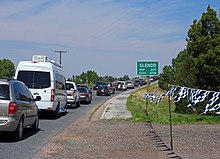
In Wyoming, estimates were that the population of the state, officially 585,000, may have doubled or even tripled, with traffic counts on August 21 showing 536,000 more cars than the five-year average for the third Monday in August; a 68 percent increase. One official offered an estimate of "two people in every car" to arrive at a one-million-visitor figure, and others noted that one million was a conservative estimate based on a one-day traffic count of limited portions of major highways. There were additional arrivals by aircraft, plus travelers who arrived early or stayed for additional days.[137] Two days before the eclipse, traffic increased 18 percent over a five-year average, with an additional 131,000 vehicles on the road.[138] Sunday saw an additional 217,000-vehicle increase.[137]
Following the eclipse, more than 500,000 vehicles traveled Wyoming roads, creating large traffic jams, particularly on southbound and eastbound highways.[139] Drivers reported that it took up to 10 hours to travel 160 miles (260 km) into northern Colorado.[137] There was one traffic fatality,[140] and another fatality related to an off-highway ATV accident, but in general there were far fewer incidents and traffic citations than authorities had anticipated.[141]

In Tennessee, the Knoxville News Sentinel described the traffic problems created by the eclipse as the worst ever seen in that part of the state. One backup along Interstate 75 reached 34 miles (55 km) in length, between Niota and the Interstate 40 interchange at Farragut. A spokesman for the state's Department of Transportation allowed that the traffic jams were the worst he had seen in six and a half years on the job, noting that accidents had aggravated the already heavy traffic flows, attributed the I-75 congestion to Knoxville-area residents heading for the totality path at Sweetwater and returning during what was the city's normal afternoon rush hour.[142]
Before the eclipse, state officials had described their traffic expectations as equivalent to that generated by the Bonnaroo Music Festival, the twice-a-season NASCAR Cup Series races at Bristol or the formerly-held Boomsday fireworks festival. "Maybe they should have considered a tsunami of traffic combining all three of those heavily attended events", the News Sentinel commented. The Tennessee Highway Patrol made sure that "[e]very trooper not on sick leave or military leave or pre-approved leave [wa]s working" the day of the eclipse; the state DOT made sure its full complement of emergency-aid HELP trucks were available as well. Alert signs on the highways also warned motorists not to pull over onto the shoulders to watch the eclipse as it could increase the risk of dangerous accidents and block the path of emergency vehicles.[142]
In North Carolina, the Department of Transportation added cameras, message boards and safety patrols in the counties where the total eclipse would take place, as well as stopping road work. The department warned that due to "unprecedented" traffic ordinary activities requiring driving might prove difficult, and advised people to act as if there were snow.[143]
In Kentucky, particularly around the Hopkinsville area, which was dubbed "Eclipseville, USA",[144] post-eclipse traffic caused extensive delays. The en masse departure of tourists via Interstate 69 as well as the Western Kentucky Parkway resulted in commute times double or even triple of normal.[145][146] The Hopkinsville-to-Lexington commute under normal circumstances lasts three and a half hours.
Impact on solar power
An eclipse causes a reduction of solar power generation where the Moon shadow covers any solar panel, as do clouds.
The North American Electric Reliability Corporation predicted minor impacts,[147] and attempted to measure the impact of the 2017 eclipse.[148] In California, solar power was projected to decrease by 4–6,000 megawatts[149] at 70 MW/minute, and then ramp up by 90 MW/minute as the shadow passes. CAISO's typical ramp rate is 29 megawatts per minute.[150] Around 4 GW mainly in North Carolina and Georgia were expected to be 90 percent obscured.[149]
After the 2017 eclipse, grid operators in California reported having lost 3,000–3,500 megawatts of utility-scale solar power, which was made up for by hydropower and gas reliably and as expected,[151][152] mimicking the usual duck curve. Energy demand management was also used to mitigate the solar drop,[153] and NEST customers reduced their demand by 700 MW.[154]
NV Energy prepared for the solar eclipse months in advance and collaborated with 17 western states. When the eclipse began covering California with partial darkness, which reduced its usual amount of solar-generated electricity, NV Energy sent power there. Likewise, when Nevada received less sunlight, other west coast states supplied electricity to it. During the solar eclipse, the state of Nevada lost about 450 megawatts of electricity, the amount used by about a quarter million typical residences.[citation needed]
Commemorative stamp
On June 20, 2017, the USPS released the first application of thermochromic ink to postage stamps in its Total Eclipse of the Sun Forever stamp to commemorate the eclipse.[155][156] When pressed with a finger, body heat turns the dark image into an image of the full moon. The stamp was released prior to August 21, so uses an image from the eclipse of March 29, 2006 seen in Jalu, Libya.[156]
Videos
- Time-lapse footage of Falls Park on the Reedy in Greenville, South Carolina
- Shadow bands on the ground in Simpsonville, South Carolina
- Animation of shadow movement from space
- Illustration of umbra (black oval), penumbra (concentric shaded ovals), and path of totality (red)
- Illustration featuring several visualizations of the event
- Short time-lapse of umbra as it moves across the clouds
- Video of the moment totality occurred in Newberry, South Carolina
Gallery
Totality
- Sequence starting at 9:06 am, totality at 10:19 am, and ending at 10:21 am PDT, as seen from Corvallis, Oregon
- Totality and prominences as seen from Glenrock, Wyoming
- Totality as seen from Columbia, Missouri
- Totality as seen from Sweetwater, Tennessee
- Totality as seen from Saint Paul, Clarendon County, South Carolina
- Totality as seen from Newberry, South Carolina
- Totality as seen from Grand Teton National Park, Wyoming
- Totality with stars as seen from Makanda, Illinois
Transition
- Beginning of Diamond ring as seen from Glenrock, Wyoming
- Diamond ring as seen from Jay Em, Wyoming
- Baily's beads before totality from far western Nebraska
- Diamond ring as seen from Corvallis, Oregon
- Diamond ring as seen from Saint Paul, South Carolina
- Diamond ring as seen from Newberry, South Carolina
- Diamond ring (with large flare) as seen from Cullowhee, NC
- Diamond ring as seen from Grand Teton National Park, Wyoming
Partial
- Seattle, Washington
- North Cascades National Park, Washington. The ISS is visible as it transits the Sun during the eclipse (4 frame composite image).
- San Francisco, California
- Mira Mesa in San Diego, California
- Far western Nebraska
- Maine at 2:41 p.m. EDT before maximum 68% coverage at 2:45 p.m.
- Ellicott City, Maryland shortly before maximum eclipse (~80%)
Images produced by natural pinholes
(Images of the eclipse created by natural pinholes formed by tree leaves)
- North Cascade mountains (British Columbia and Washington)
Views outside of the US
- Photograph of the eclipse projected with binoculars in Puebla, Mexico
- Photograph of the eclipse projected with binoculars in Puebla, Mexico
Eclipse details
Shown below are two tables displaying details about this particular solar eclipse. The first table outlines times at which the moon's penumbra or umbra attains the specific parameter, and the second table describes various other parameters pertaining to this eclipse.[157]
| Event | Time (UTC) |
|---|---|
| First Penumbral External Contact | 2017 August 21 at 15:47:59.9 UTC |
| First Umbral External Contact | 2017 August 21 at 16:49:44.5 UTC |
| First Central Line | 2017 August 21 at 16:50:14.5 UTC |
| First Umbral Internal Contact | 2017 August 21 at 16:50:44.6 UTC |
| First Penumbral Internal Contact | 2017 August 21 at 18:13:05.6 UTC |
| Equatorial Conjunction | 2017 August 21 at 18:14:22.8 UTC |
| Greatest Duration | 2017 August 21 at 18:22:57.5 UTC |
| Greatest Eclipse | 2017 August 21 at 18:26:40.3 UTC |
| Ecliptic Conjunction | 2017 August 21 at 18:31:19.6 UTC |
| Last Penumbral Internal Contact | 2017 August 21 at 18:40:33.4 UTC |
| Last Umbral Internal Contact | 2017 August 21 at 20:02:48.0 UTC |
| Last Central Line | 2017 August 21 at 20:03:15.4 UTC |
| Last Umbral External Contact | 2017 August 21 at 20:03:42.8 UTC |
| Last Penumbral External Contact | 2017 August 21 at 21:05:31.9 UTC |
| Parameter | Value |
|---|---|
| Eclipse Magnitude | 1.03059 |
| Eclipse Obscuration | 1.06211 |
| Gamma | 0.43671 |
| Sun Right Ascension | 10h04m03.9s |
| Sun Declination | +11°51'43.0" |
| Sun Semi-Diameter | 15'48.7" |
| Sun Equatorial Horizontal Parallax | 08.7" |
| Moon Right Ascension | 10h04m30.6s |
| Moon Declination | +12°16'32.8" |
| Moon Semi-Diameter | 16'03.4" |
| Moon Equatorial Horizontal Parallax | 0°58'55.7" |
| ΔT | 68.8 s |
Eclipse season
This eclipse is part of an eclipse season, a period, roughly every six months, when eclipses occur. Only two (or occasionally three) eclipse seasons occur each year, and each season lasts about 35 days and repeats just short of six months (173 days) later; thus two full eclipse seasons always occur each year. Either two or three eclipses happen each eclipse season. In the sequence below, each eclipse is separated by a fortnight.
| August 7 Descending node (full moon) |
August 21 Ascending node (new moon) |
|---|---|
 |
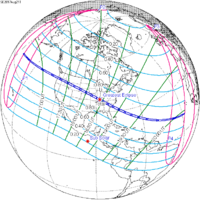
|
| Partial lunar eclipse Lunar Saros 119 |
Total solar eclipse Solar Saros 145 |
Related eclipses
Eclipses in 2017
- A penumbral lunar eclipse on February 11.
- An annular solar eclipse on February 26.
- A partial lunar eclipse on August 7.
- A total solar eclipse on August 21.
Metonic
- Preceded by: Solar eclipse of November 3, 2013
- Followed by: Solar eclipse of June 10, 2021
Tzolkinex
- Preceded by: Solar eclipse of July 11, 2010
- Followed by: Solar eclipse of October 2, 2024
Half-Saros
- Preceded by: Lunar eclipse of August 16, 2008
- Followed by: Lunar eclipse of August 28, 2026
Tritos
- Preceded by: Solar eclipse of September 22, 2006
- Followed by: Solar eclipse of July 22, 2028
Solar Saros 145
- Preceded by: Solar eclipse of August 11, 1999
- Followed by: Solar eclipse of September 2, 2035
Inex
- Preceded by: Solar eclipse of September 11, 1988
- Followed by: Solar eclipse of August 2, 2046
Triad
- Preceded by: Solar eclipse of October 21, 1930
- Followed by: Solar eclipse of June 22, 2104
Solar eclipses of 2015–2018
This eclipse is a member of a semester series. An eclipse in a semester series of solar eclipses repeats approximately every 177 days and 4 hours (a semester) at alternating nodes of the Moon's orbit.[158]
The partial solar eclipse on July 13, 2018 occurs in the next lunar year eclipse set.
| Solar eclipse series sets from 2015 to 2018 | ||||||
|---|---|---|---|---|---|---|
| Descending node | Ascending node | |||||
| Saros | Map | Gamma | Saros | Map | Gamma | |
120 Totality in Longyearbyen, Svalbard |
March 20, 2015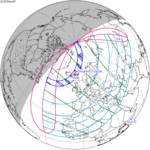 Total |
0.94536 | 125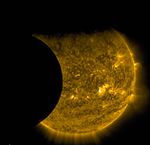 Solar Dynamics Observatory |
September 13, 2015  Partial |
−1.10039 | |
130 Balikpapan, Indonesia |
March 9, 2016 Total |
0.26092 | 135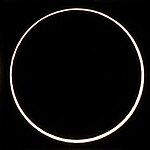 Annularity in L'Étang-Salé, Réunion |
September 1, 2016 Annular |
−0.33301 | |
140 Partial from Buenos Aires, Argentina |
February 26, 2017 Annular |
−0.45780 | 145 Totality in Madras, OR, USA |
August 21, 2017 Total |
0.43671 | |
150 Partial in Olivos, Buenos Aires, Argentina |
February 15, 2018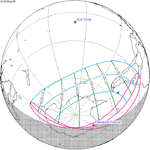 Partial |
−1.21163 | 155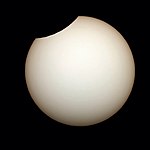 Partial in Huittinen, Finland |
August 11, 2018 Partial |
1.14758 | |
Saros 145
This eclipse is a part of Saros series 145, repeating every 18 years, 11 days, and containing 77 events. The series started with a partial solar eclipse on January 4, 1639. It contains an annular eclipse on June 6, 1891; a hybrid eclipse on June 17, 1909; and total eclipses from June 29, 1927 through September 9, 2648. The series ends at member 77 as a partial eclipse on April 17, 3009. Its eclipses are tabulated in three columns; every third eclipse in the same column is one exeligmos apart, so they all cast shadows over approximately the same parts of the Earth.
The longest duration of annularity was produced by member 15 at 6 seconds (by default) on June 6, 1891, and the longest duration of totality will be produced by member 50 at 7 minutes, 12 seconds on June 25, 2522. All eclipses in this series occur at the Moon’s ascending node of orbit.[159]
| Series members 10–32 occur between 1801 and 2200: | ||
|---|---|---|
| 10 | 11 | 12 |
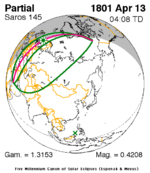 April 13, 1801 |
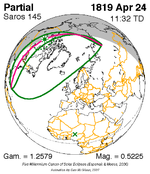 April 24, 1819 |
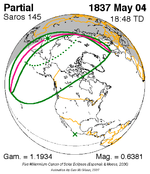 May 4, 1837 |
| 13 | 14 | 15 |
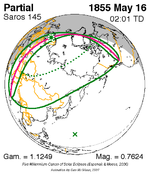 May 16, 1855 |
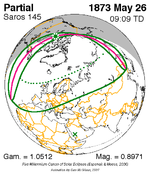 May 26, 1873 |
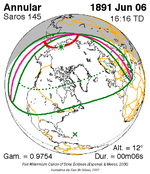 June 6, 1891 |
| 16 | 17 | 18 |
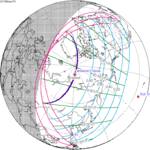 June 17, 1909 |
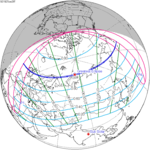 June 29, 1927 |
 July 9, 1945 |
| 19 | 20 | 21 |
 July 20, 1963 |
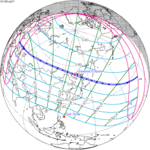 July 31, 1981 |
 August 11, 1999 |
| 22 | 23 | 24 |
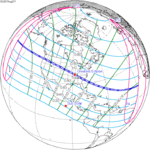 August 21, 2017 |
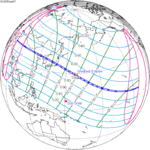 September 2, 2035 |
 September 12, 2053 |
| 25 | 26 | 27 |
 September 23, 2071 |
 October 4, 2089 |
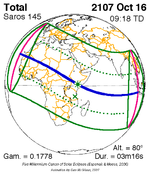 October 16, 2107 |
| 28 | 29 | 30 |
 October 26, 2125 |
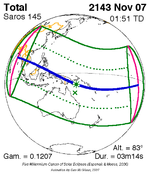 November 7, 2143 |
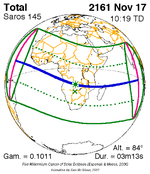 November 17, 2161 |
| 31 | 32 | |
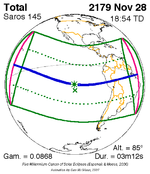 November 28, 2179 |
 December 9, 2197 | |
Metonic series
The metonic series repeats eclipses every 19 years (6939.69 days), lasting about 5 cycles. Eclipses occur in nearly the same calendar date. In addition, the octon subseries repeats 1/5 of that or every 3.8 years (1387.94 days). All eclipses in this table occur at the Moon's ascending node.
| 20 eclipse events between June 10, 1964 and August 21, 2036 | ||||
|---|---|---|---|---|
| June 10–11 | March 28–29 | January 14–16 | November 3 | August 21–22 |
| 117 | 119 | 121 | 123 | 125 |
 June 10, 1964 |
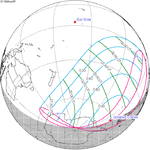 March 28, 1968 |
 January 16, 1972 |
 November 3, 1975 |
 August 22, 1979 |
| 127 | 129 | 131 | 133 | 135 |
 June 11, 1983 |
 March 29, 1987 |
 January 15, 1991 |
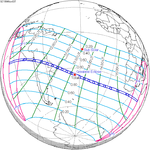 November 3, 1994 |
 August 22, 1998 |
| 137 | 139 | 141 | 143 | 145 |
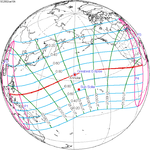 June 10, 2002 |
 March 29, 2006 |
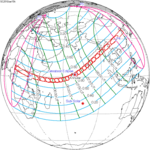 January 15, 2010 |
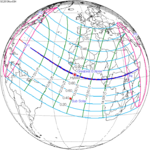 November 3, 2013 |
 August 21, 2017 |
| 147 | 149 | 151 | 153 | 155 |
 June 10, 2021 |
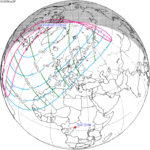 March 29, 2025 |
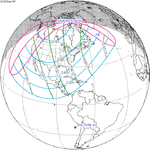 January 14, 2029 |
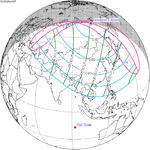 November 3, 2032 |
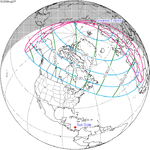 August 21, 2036 |
Tritos series
This eclipse is a part of a tritos cycle, repeating at alternating nodes every 135 synodic months (≈ 3986.63 days, or 11 years minus 1 month). Their appearance and longitude are irregular due to a lack of synchronization with the anomalistic month (period of perigee), but groupings of 3 tritos cycles (≈ 33 years minus 3 months) come close (≈ 434.044 anomalistic months), so eclipses are similar in these groupings.
| Series members between 1801 and 2200 | ||||
|---|---|---|---|---|
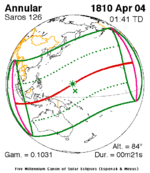 April 4, 1810 (Saros 126) |
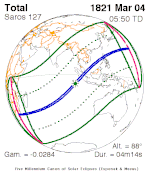 March 4, 1821 (Saros 127) |
 February 1, 1832 (Saros 128) |
 December 31, 1842 (Saros 129) |
 November 30, 1853 (Saros 130) |
 October 30, 1864 (Saros 131) |
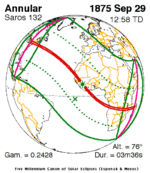 September 29, 1875 (Saros 132) |
 August 29, 1886 (Saros 133) |
 July 29, 1897 (Saros 134) |
 June 28, 1908 (Saros 135) |
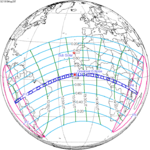 May 29, 1919 (Saros 136) |
 April 28, 1930 (Saros 137) |
 March 27, 1941 (Saros 138) |
 February 25, 1952 (Saros 139) |
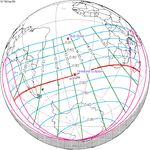 January 25, 1963 (Saros 140) |
 December 24, 1973 (Saros 141) |
 November 22, 1984 (Saros 142) |
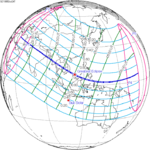 October 24, 1995 (Saros 143) |
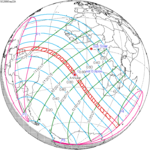 September 22, 2006 (Saros 144) |
 August 21, 2017 (Saros 145) |
 July 22, 2028 (Saros 146) |
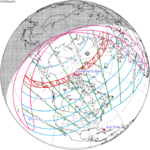 June 21, 2039 (Saros 147) |
 May 20, 2050 (Saros 148) |
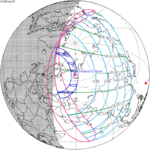 April 20, 2061 (Saros 149) |
 March 19, 2072 (Saros 150) |
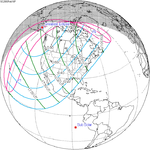 February 16, 2083 (Saros 151) |
 January 16, 2094 (Saros 152) |
 December 17, 2104 (Saros 153) |
 November 16, 2115 (Saros 154) |
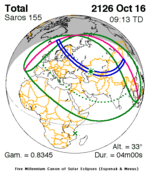 October 16, 2126 (Saros 155) |
 September 15, 2137 (Saros 156) |
 August 14, 2148 (Saros 157) |
 July 15, 2159 (Saros 158) |
 June 14, 2170 (Saros 159) |
 May 13, 2181 (Saros 160) |
 April 12, 2192 (Saros 161) | ||||
Inex series
This eclipse is a part of the long period inex cycle, repeating at alternating nodes, every 358 synodic months (≈ 10,571.95 days, or 29 years minus 20 days). Their appearance and longitude are irregular due to a lack of synchronization with the anomalistic month (period of perigee). However, groupings of 3 inex cycles (≈ 87 years minus 2 months) comes close (≈ 1,151.02 anomalistic months), so eclipses are similar in these groupings.
| Series members between 1801 and 2200 | ||
|---|---|---|
 January 10, 1815 (Saros 138) |
 December 21, 1843 (Saros 139) |
 November 30, 1872 (Saros 140) |
 November 11, 1901 (Saros 141) |
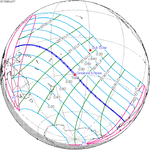 October 21, 1930 (Saros 142) |
 October 2, 1959 (Saros 143) |
 September 11, 1988 (Saros 144) |
 August 21, 2017 (Saros 145) |
 August 2, 2046 (Saros 146) |
 July 13, 2075 (Saros 147) |
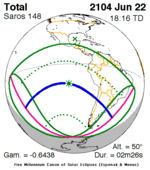 June 22, 2104 (Saros 148) |
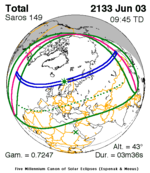 June 3, 2133 (Saros 149) |
 May 14, 2162 (Saros 150) |
 April 23, 2191 (Saros 151) |
|
See also
References
- ^ See, e.g., Steed, Edward (September 4, 2017), "The Great American Eclipse of 2017", The New Yorker, retrieved October 29, 2017; Massimino, Mike (narrator) (August 22, 2017), The Great American Eclipse, Science Channel, retrieved October 29, 2017; Redd, Nola Taylor (September 29, 2017), "What the 2017 Solar Eclipse Taught Us About Boosting Public Interest in Science", space.com, Purch Group, retrieved October 29, 2017; Zhang, Michael (September 22, 2017), "A Near-IR Photo of the Moon's Shadow During the Great American Eclipse", PetaPixel, retrieved October 29, 2017; Lakind, Sean (September 12, 2017), "The Great American Eclipse And Its Effect On Retail Traffic", Forbes, retrieved October 29, 2017.
- ^ a b c Chan, Melissa (July 25, 2017). "The 2017 Total Solar Eclipse: Everything You Need to Know". Time. Retrieved August 22, 2017.
- ^ Wolfram, Stephen (August 15, 2017). "When Exactly Will the Eclipse Happen? A Multimillenium Tale of Computation". Wolfram Blog. Retrieved August 17, 2017.
- ^ "How to view the partial solar eclipse in Hawaii". KHON2 Nexstar Media Group. August 15, 2017. Archived from the original on August 22, 2017. Retrieved August 21, 2017.
- ^ ABC News (August 22, 2017). "Total solar eclipse experience from coast to coast". Archived from the original on December 22, 2021 – via YouTube.
- ^ a b Celestron (September 26, 2017). "Eclipse Across America" – via YouTube.
- ^ a b "Wyoming prepares for total solar eclipse in 2017". CTV News. Associated Press. August 19, 2017. Retrieved August 24, 2017.
- ^ a b c "Amazon offers refunds to customers who bought fake eclipse glasses". CBC News. August 15, 2017. Retrieved August 19, 2017.
- ^ "Moon Distances for London, United Kingdom, England". timeanddate. Retrieved August 12, 2024.
- ^ a b c "Eclipse: Who? What? Where? When? and How?". NASA. Retrieved October 18, 2018.
- ^ "Voyages of Discovery: 2017 Total Solar Eclipse". astroadventures.net. Astro Adventures. Archived from the original on July 30, 2017. Retrieved July 30, 2017.
- ^ Malik, Tariq (August 18, 2017). "Here's a Timeline of When the 2017 Solar Eclipse Begins and Ends". space.com. Retrieved August 21, 2017.
- ^ "The Solar Eclipse: What to Expect". The New York Times. August 21, 2017. Retrieved August 21, 2017.
- ^ "2017 August 21 Total Solar Eclipse". USNO. Archived from the original on October 12, 2014. Retrieved April 25, 2014.
- ^ Nicholls, Will (August 3, 2017). "NASA to Chase Solar Eclipse with Jets for Clearest Ever Photos of Corona". PetaPixel. Retrieved August 21, 2017.
- ^ SmarterEveryDay (August 22, 2017). "Space Station Transiting 2017 ECLIPSE, My Brain Stopped Working – Smarter Every Day 175". Archived from the original on December 22, 2021 – via YouTube.
- ^ "August 21, 2017 — Great American Eclipse (Total Solar Eclipse)". timeanddate. Retrieved April 12, 2024.
- ^ "See 4 planets during the total eclipse - EarthSky.org". earthsky.org. August 21, 2017.
- ^ "The Great Baja Eclipse", Discover January 1991. p. 90.
- ^ "Total and Annular Solar Eclipse Paths 1981–2000". NASA. Archived from the original on March 27, 2009.
- ^ "Total and Annular Solar Eclipse Paths 1961–1980". NASA. Archived from the original on March 27, 2009.
- ^ Espenak, Fred. "Total Solar Eclipse of 1970 Mar 07". NASA. Archived from the original on February 5, 2012.
- ^ "Thousands Go West for a Total Solar Eclipse Tomorrow; Data May Aid Energy Research Partial Eclipse for New York Best Types of Film Image of Sun on Screen", The New York Times February 25, 1979. p. 26.
- ^ Browne, Malcolm W. (February 27, 1979). "Total Eclipse of the Sun Darkens Skies in Northwest; Total Eclipse Casts Two Minutes of Darkness in West Temperature Falls Sharply Learned of Weather Peculiarities Data on Plasma Sought" (PDF). The New York Times. p. C4. Retrieved February 19, 2017.
- ^ Jubier, Xavier; Espenak, Fred. "NASA – Total Solar Eclipse of 1257 June 13". NASA. Archived from the original on July 26, 2012.
- ^ "X Marks the Spot: Two Total Solar Eclipses in Seven Years". National Eclipse. June 28, 2016. Retrieved October 7, 2024.
- ^ Jubier, Xavier M. (2011). "Google Earth Gallery for Solar and Lunar Eclipses". Retrieved August 22, 2017.
- ^ "OSU150 Space Grant Festival: A Total Eclipse Experience". Oregon State University. April 20, 2017. Retrieved August 22, 2017.
- ^ "Where to watch the total solar eclipse in Eastern Oregon". East Oregonian. July 7, 2017. Retrieved November 5, 2017.
- ^ "EclipseFest". Salem-Keizer Volcanoes. Retrieved August 8, 2017.
- ^ "Eclipse chasers blaze trail to Oregon for view of a lifetime". The Seattle Times. June 23, 2017. Retrieved June 30, 2017.
- ^ "'Tremendous event': Man describes viewing eclipse as 'caveman like'". The Argus Observer. August 22, 2017. Retrieved August 17, 2022.
- ^ "Oregon Scores International Collaborative Festival With 'Oregon Eclipse'". Dance Music NW. November 11, 2016. Retrieved November 13, 2016.
- ^ "Oregon Eclipse — A Total Solar Eclipse Gathering 17–23 August, 2017". oregoneclipse2017.com. Retrieved November 13, 2016.
- ^ Colin Day (September 6, 2017). "Oregon Eclipse 2017 – Symbiosis". Archived from the original on December 22, 2021 – via YouTube.
- ^ "Saturday Oregon solar eclipse updates on traffic, crowds and events". Statesman Journal. Retrieved August 30, 2017.
- ^ "OMSI Total Solar Eclipse Viewing in Salem, Oregon — August 21, 2017". NASA. Retrieved April 2, 2017.
- ^ a b "Event Details – Craters Of The Moon National Monument & Preserve". U.S. National Park Service. Retrieved August 8, 2017.
- ^ "Events Around Eastern Idaho". Eastern Idaho Eclipse. October 24, 2016. Archived from the original on August 8, 2017. Retrieved August 8, 2017.
- ^ "Idaho Falls Eclipse". Big Kid Science. March 22, 2017. Retrieved August 8, 2017.
- ^ "Total Solar Eclipse 2017". Brigham Young University Idaho. Archived from the original on April 4, 2017. Retrieved April 2, 2017.
- ^ "Eclipse Festival and Map". Weiser Eclipse 2017. Archived from the original on August 19, 2017. Retrieved August 8, 2017.
- ^ Sandlin, Destin (August 22, 2017). "Space Station Transiting 2017 ECLIPSE, My Brain Stopped Working - Smarter Every Day 175". YouTube. Retrieved April 1, 2024.
- ^ "2017Astrocon, Casper, Wyoming". Astronomical League. Archived from the original on April 4, 2017. Retrieved April 3, 2017.
a unique opportunity for professional astronomers to intermingle with knowledgeable amateurs; gathering together to learn from each other and exchange ideas.
- ^ "Wyoming Eclipse Festival 2017". Archived from the original on August 21, 2017. Retrieved April 2, 2017.
- ^ "2017 Great American Eclipse, Fort Laramie". National Park Service. Retrieved August 21, 2017.
- ^ "zaćmienie Słońca i ciemne niebo". Urania – Postępy Astronomii (in Polish). August 7, 2017. Retrieved May 11, 2018.
- ^ "Eclipse Events". 2017 Solar Eclipse in Alliance. Archived from the original on April 4, 2017. Retrieved April 2, 2017.
- ^ Crowds at Carhenge in Nebraska eager to view solar eclipse (ABC News, August 21, 2017)
- ^ "Eclipse Lunch on the Lawn". Nemaha County Hospital. Retrieved August 22, 2017 – via Facebook.
- ^ "Total Solar Eclipse Weekend of Events at Homestead National Monument of America – Homestead National Monument of America". U.S. National Park Service. Retrieved August 6, 2017.
- ^ a b YouTube: Eclipse 2017: One Nation Under the Sun Published August 27, 2017, (National Monument displayed at 0:58, 4:42 4:53, 6:31; Lincoln baseball game at 0:44, 1:36, 5:47).
- ^ "Gem of the Prairie Eclipse Event". stuhrmuseum.org. Stuhr Museum. Archived from the original on July 31, 2017.
- ^ "Eight-run Inning Carries Saltdogs Over Railcats in Special Solar Eclipse Game". Lincoln Saltdogs. August 21, 2017.
- ^ "The Great American Eclipse Viewing at Benedictine College". Benedictine College.
- ^ "Show me totality COMO". Lathrop Eclipse. Retrieved August 20, 2017.
- ^ "MU hosts weekend full of events leading to Mondays solar eclipse". Lathrop Eclipse. August 19, 2017. Retrieved August 20, 2017.
- ^ "Eclipse 2017". Lathrop Eclipse. Archived from the original on August 20, 2017. Retrieved August 20, 2017.
- ^ "Total solar eclipse ride". KC-PPC. Archived from the original on March 29, 2022. Retrieved May 1, 2017.
- ^ "Total Solar Eclipse/150 Years Festival". Lathrop Eclipse. Retrieved April 2, 2017.
- ^ "Eclipsing Park University". Park University. Archived from the original on August 16, 2017. Retrieved July 13, 2017.
- ^ "Darkening of the Sun – Eclipse 2017 – St. Clair MO".
- ^ "St. Joseph Eclipse". Front Page Science. Archived from the original on August 22, 2017. Retrieved April 3, 2017.
- ^ Armstrong, Bethany (August 1, 2017). "The 4321 Event w/ Tipper & Friends Set to Amaze during 2017's Total Solar Eclipse". Music Festival Central. Archived from the original on November 17, 2017. Retrieved November 16, 2017.
- ^ "Southern Illinois: eclipse crossroads of America". Southern Illinois University Carbondale. May 5, 2016. Archived from the original on March 24, 2017.
- ^ Johnston, Bob (August 7, 2017). "Amtrak announces 'Eclipse Express' special to southern Illinois". Trains. Archived from the original on August 10, 2017. Retrieved August 14, 2017.
- ^ "Southern Illinois University Carbondale (NASA EDGE)". NASA. Archived from the original on March 19, 2017. Retrieved August 20, 2017.
- ^ Carley, Sean (March 28, 2017). "Remainder of "Moonstock" eclipse festival lineup announced". Daily Egyptian. Retrieved April 2, 2017.
- ^ "View the Eclipse with University of Illinois Astronomers in Goreville, IL". University of Illinois at Urbana–Champaign. Retrieved May 3, 2017.
- ^ "WKU Eclipse Events". Western Kentucky University. Retrieved August 22, 2017.
- ^ a b c d Stephen, Eric (August 21, 2017). "Solar eclipse 2017: The 5 minor league games being played during Aug. 21 event". SBNation. Retrieved August 22, 2017.
- ^ "A Monumental Solar Eclipse Festival: August 18 – August 21". Solar Eclipse Hopkinsville, KY. Archived from the original on April 1, 2017. Retrieved April 2, 2017.
- ^ "Total Eclipse of the Park". athenschamber.org. Athens Area Chamber of Commerce. Archived from the original on August 24, 2017. Retrieved August 24, 2017.
- ^ "Eclipse: Events". Austin Peay State University. Archived from the original on August 1, 2017. Retrieved April 3, 2017.
- ^ "Blackout 2017". mainstreetmcminnville.org. Main Street McMinville. Archived from the original on August 18, 2017. Retrieved August 18, 2017.
- ^ "Eclipse-Themed Programs & Events". Music City Solar Eclipse. Archived from the original on August 19, 2017. Retrieved April 2, 2017.
- ^ "Nashville's Italian Lights festival is official NASA location for solar eclipse". Music City Eclipse at Italian Lights Festival. WKRN News2. Archived from the original on July 23, 2017. Retrieved July 22, 2017.
- ^ "Solar Eclipse 2017 Viewing Event, Free Music City Eclipse Party". Music City Eclipse at Italian Lights Festival. Retrieved July 20, 2017.
- ^ "The 2017 Total Solar Eclipse Will Pass Through the Great Smoky Mountains of North Carolina". Bryson City North Carolina. Archived from the original on August 1, 2017. Retrieved April 2, 2017.
- ^ Reinhart, Vince (August 21, 2017). "Eclipse – Cullowhee North Carolina" – via Flickr.
- ^ "Eclipse leaves thousands breathless at UGA's Sanford Stadium". WXIA. August 21, 2017. Retrieved August 21, 2017.[permanent dead link]
- ^ "Get Off the Grid Fest". Get Off the Grid Fest. Retrieved August 22, 2017.
- ^ Eclipse awes those gathered at Georgia Guidestones, by Wayne Ford (Athens Banner-Herald, August 21, 2017)
- ^ "NASA to Broadcast Eclipse from .CofC". The College Today. June 21, 2017. Retrieved August 23, 2017.
- ^ Melvin, Jim (August 21, 2017). "Watch Live: When, where and how to watch the total solar eclipse at Clemson University". Clemson University. Archived from the original on August 22, 2017. Retrieved August 21, 2017.
- ^ "Solar Eclipse 2017 at the South Carolina State Museum". South Carolina State Museum. Retrieved August 22, 2017.
- ^ "Eclipse at Furman". Furman University. Archived from the original on June 15, 2017. Retrieved May 5, 2017.
- ^ "Total Eclipse Watch Party". sumtersc.gov. City of Sumter. Archived from the original on August 23, 2017.
- ^ Mortillaro, Nicole (July 2, 2017). "When day turns into night: Canadians, Americans prepare for total solar eclipse". CBC News. Retrieved July 2, 2017.
- ^ "Eclipse viewing party at Canada Aviation and Space Museum | CTV News". ctvnews.com. August 20, 2017. Retrieved August 20, 2017.
- ^ "Where to watch the eclipse in the Toronto area | Toronto Star". thestar.com. August 20, 2017. Retrieved August 26, 2017.
- ^ "Bonnie Tyler Will Sing 'Total Eclipse of the Heart' During the Actual Total Solar Eclipse". Space.com. August 19, 2017. Retrieved August 21, 2017.
- ^ Melissa Mahtani (August 21, 2017). "Bonnie Tyler sings 'Total Eclipse of the Heart' live on CNN". CNN. Retrieved July 2, 2021.
- ^ Chabeli Herrera (August 22, 2017). "Here's Bonnie Tyler singing 'Total Eclipse of the Heart' during the eclipse". Miami Herald. Retrieved July 2, 2021.
- ^ Littmann, Espenak, Willcox: Totality: Eclipses of the Sun. pp 253ff
- ^ "Total Eclipse of the Sun" (PDF). Archived from the original (PDF) on August 26, 2017. Retrieved August 26, 2017.
- ^ Map of Total Solar Eclipse on August 21, 2017 — timeanddate.com
- ^ "Local Circumstances of the partial eclipse in Anadyr". Archived from the original on August 26, 2017. Retrieved August 26, 2017.
- ^ a b Rubin, Molly (August 15, 2017). "How to watch the Great American Eclipse, no matter where you are in the world". Quartz. Retrieved August 18, 2017.
- ^ Katz, A.J. (August 17, 2017). "Here Are The TV Network Plans For Covering the Total Solar Eclipse". TVNewser. Adweek. Retrieved August 18, 2017.
- ^ Nyren, Erin (August 18, 2017). "Solar Eclipse Coverage: TV Goes Totally Looney for Lunar Moment". Variety. Retrieved August 18, 2017.
- ^ Potenza, Alessandra (August 15, 2017). "Why NASA is sending bacteria into the sky on balloons during the eclipse". The Verge. Retrieved August 18, 2017.
- ^ MOELLER, KATY (August 24, 2017). "Eclipse observation balloon went missing. Did it land in Treasure Valley?". The Idaho Statesman. Retrieved August 24, 2017.
- ^ "The Eclipse 2017 Umbra Viewed from Space". NASA. August 21, 2017. Retrieved August 24, 2017.
- ^ Wong, Herman. "Trump celebrates solar eclipse by looking up without special viewing glasses". The Washington Post. Retrieved August 23, 2017.
- ^ Parker, Ryan (August 21, 2017). "Trump Looking at Eclipse Without Glasses Becomes Instant Meme". The Hollywood Reporter. Archived from the original on December 4, 2022. Retrieved November 7, 2024.
- ^ Nevins, Jake (August 22, 2017). "Late-night hosts on the solar eclipse: 'That was Melania's chance to escape'". The Guardian. Retrieved November 7, 2024.
- ^ O'Connell, Oliver (April 8, 2024). "Trump trolled ahead of eclipse for staring directly at the sun". The Independent. New York. Archived from the original on April 18, 2024. Retrieved November 7, 2024.
- ^ Ghose, Tia (August 22, 2017). "The Solar Eclipse Had a Spooky Effect on Nature". Live Science. Retrieved August 26, 2017.
- ^ Gaudette, Emily (August 23, 2017). "Pornhub Was Shocked by How Total Solar Eclipse Affected Their Viewers: The great cosmic ballet briefly distracted people from porn". Inverse Culture. Retrieved April 11, 2018.
- ^ "The solar eclipse was viewed over 90 million times on NASA website". The Economic Times. August 26, 2017. Archived from the original on August 26, 2017. Retrieved August 26, 2017.
- ^ a b Wolfson, Elijah (July 27, 2017). "Solar-eclipse fever means counterfeit glasses are flooding Amazon's market". Quartz. Retrieved August 19, 2017.
- ^ a b "How to Tell If Your Eclipse Glasses or Handheld Solar Viewers Are Safe". Solar Eclipse Across America – August 21, 2017. American Astronomical Society. February 23, 2017. Retrieved August 20, 2017. Includes photos of genuine and fake eclipse glasses.
- ^ Pittman, Travis (August 18, 2017). "Here's How Fast Your Retina Could Burn Looking at Eclipse Unprotected". Denver, Colorado: 9 News.
- ^ "Eclipse Glasses Safety". Eclipse Glasses.com. Retrieved August 20, 2017.
- ^ Czebiniak, Madasyn (August 23, 2017). "Springdale library 'sickened' by discovery of counterfeit eclipse glasses". Trib Live. metro Pittsburgh. Retrieved September 2, 2017.
- ^ Elliott, Matt (August 19, 2017). "How to tell if your solar eclipse glasses are safe or fake". CNET. Retrieved August 19, 2017.
- ^ "Rental Camera Gear Destroyed by the Solar Eclipse of 2017". LensRentals Blog. September 1, 2017. Retrieved November 12, 2017.
- ^ Mariano, Nick (June 17, 2016). "Local tourism, businesses make plans for solar eclipse in 2017". The Southern Illinosian. Retrieved July 29, 2017.
- ^ Serven, Ruth (July 13, 2017). "Total solar eclipse offers small towns a tourism boom—if they can get ready". The Kansas City Star. Retrieved July 29, 2017.
- ^ Richy, Brad (July 29, 2017). "Letter to Eclipse Communities" (PDF). Idaho Office of Emergency Management.
- ^ Moeller, Katy (August 17, 2017). "Oregon eclipse traffic is already backing up. Idaho has an app for that". The Idaho Statesman. Retrieved August 17, 2017.
- ^ "Oregon governor authorizes National Guard for solar eclipse". KBTX-TV. Associated Press. July 27, 2017. Retrieved July 29, 2017.
- ^ Lynne, Terry (August 10, 2017). "Eclipse 2017: Hospitals stock up on blood, rattlesnake bite antidote". The Oregonian. Retrieved August 10, 2017.
- ^ Hale, Jamie (April 3, 2017). "Oregon hotels unapologetic, silent about widespread eclipse cancellations". OregonLive.com. Retrieved September 8, 2017.
- ^ Guevarra, Ericka (July 28, 2017). "Customers Get Payments From Oregon Hotels That Canceled, Raised Prices For Eclipse". Oregon Public Broadcasting. Retrieved September 8, 2017.
- ^ Bach, Jonathan (July 31, 2017). "Grand Hotel to pay customers for eclipse reservation problems". Statesman Journal. Retrieved September 8, 2017.
- ^ a b Erickson, David (August 23, 2017). "Eclipse: Construction causes huge I-15 traffic jam; Montana official apologizes". Missoulian. Retrieved August 24, 2017.
- ^ Rao, Joe (August 19, 2017). "Get Ready for Major Traffic Jams During the 2017 Solar Eclipse". Space.com. Retrieved August 21, 2017.
- ^ Mitchell, Russ (August 20, 2017). "Solar eclipse gridlock: It was so busy in Madras, Ore., they called in the National Guard". Los Angeles Times. ISSN 0458-3035. Retrieved August 21, 2017.
- ^ Harbager, Molly (August 21, 2017). "Eclipse jams traffic on runways, not just roads, with hundreds of planes in Madras waiting". The Oregonian. Retrieved August 22, 2017.
- ^ "I-15 projects to shut down for eclipse". KIFI-TV. August 17, 2017. Archived from the original on August 24, 2017. Retrieved August 24, 2017.
- ^ a b Mims, Bob (August 21, 2017). "Traffic into Utah jammed as eclipse fans head home on Interstate 15". Salt Lake Tribune. Retrieved August 24, 2017.
- ^ Carr, Ada; Breslin, Sean (August 21, 2017). "Solar Eclipse Traffic: Interstates Busy as Final Travelers Hit the Road". The Weather Channel. Retrieved August 21, 2017.
- ^ Sunderland, Nate (August 21, 2017). "Bumper-to-bumper traffic on I-15 as eclipse viewers leave Idaho". KSL-TV. Retrieved August 24, 2017.
- ^ "Solar Eclipse Traffic Counts". Idaho Transportation Department. August 18, 2017. Retrieved August 21, 2017.
- ^ a b c Peterson, Christine (August 23, 2017). "More than a million people may have visited Wyoming for eclipse; one person came by sea plane". Casper Star-Tribune Online. Retrieved August 24, 2017.
- ^ "Traffic increases 18 percent over a five-year average on Saturday as Aug. 21 eclipse nears". Wyoming Department of Transportation. August 20, 2017. Archived from the original on August 21, 2017. Retrieved August 21, 2017.
- ^ Rainey, Libby (August 22, 2017). "Wyoming solar eclipse traffic jam was one for the record books". The Denver Post. Retrieved August 24, 2017.
- ^ Sanderson, Shane (August 23, 2017). "Highway patrol releases new details about Colorado motorcyclist killed in Eclipse traffic". Casper Star-Tribune Online. Retrieved August 24, 2017.
- ^ Sanderson, Shane (August 23, 2017). "Eclipse keeps highway patrol busy, but local authorities respond to fewer incidents than expected". Casper Star-Tribune Online. Retrieved August 24, 2017.
- ^ a b Jacobs, Don (August 21, 2017). "Worst traffic snarls ever seen in East Tennessee". Knoxville News Sentinel. Retrieved August 26, 2017.
- ^ "Western NC ready for eclipse, but roads clogged". Winston-Salem Journal. Associated Press. August 21, 2017. Retrieved August 21, 2017.
- ^ Williams, Chris (July 22, 2017). "Welcome to 'Eclipseville,' Hopkinsville, Ky, USA". WHAS. Retrieved October 17, 2017.
- ^ Stunson, Mike (August 22, 2017). "The rare eclipse was memorable. The ride home was something they want to forget". Lexington Herald-Leader. Retrieved October 17, 2017.
Once we left Hopkinsville ... It took us 10 hours to go 210 miles, and we didn't return to our home in Lexington until just after midnight.
- ^ Helmer, Katrina (August 21, 2017). "As solar eclipse ends, traffic stalls heading out of Hopkinsville". WDRB. Retrieved October 17, 2017.
As of 10 p.m., drivers were still on the roads trying to get back to Louisville more than seven hours after leaving Hopkinsville.
- ^ "A Wide-Area Perspective on the August 21, 2017 Total Solar Eclipse" (PDF). North American Electric Reliability Corporation. April 2017. p. 20. Archived from the original (PDF) on June 26, 2017. Retrieved May 1, 2017.
The analysis performed in this study showed no reliability impacts to bulk power system (BPS) operations.
- ^ "2016 Long-Term Reliability Assessment" (PDF). North American Electric Reliability Corporation. December 2016. p. 70. Retrieved April 18, 2017.
causes substantial effects to wide-scale solar generation within a very short amount of time. The output generated by PV/solar systems will be either diminished or drastically reduced within the window of this event. Sudden widespread diminishing of solar irradiance may heavily affect areas with large amounts of utility scale PV energy installations or behind-the-meter DERs.
- ^ a b "Solar eclipse on August 21 will affect photovoltaic generators across the country – Today in Energy". U.S. Energy Information Administration (EIA). August 7, 2017. Retrieved August 13, 2017.
- ^ Pyper, Julia (May 11, 2017). "This Summer's Eclipse Will Put California's Solar-Powered Grid to the Test". Greentech Media. Retrieved May 14, 2017.
- ^ Grandoni, Dino (August 21, 2017). "California is the state that most depends on the sun for energy. It survived the eclipse without losing any". The Washington Post. Retrieved August 23, 2017.
- ^ Baker, David R. (August 21, 2017). "California power grid survives solar eclipse unscathed". SFGate. Retrieved August 23, 2017.
- ^ Pyper, Julia (August 21, 2017). "Looking Beyond the Eclipse: How the Historic Event Tested Customer Engagement on the Electric Grid". Retrieved August 23, 2017.
Today's eclipse is a test run for the electricity community. So we have exactly the same challenge on a regular basis within the grid because of solar.
- ^ "DR Dialogue: Nest's Solar Eclipse Rush Hour Rewards Program". www.peakload.org. July 19, 2018. Retrieved April 30, 2019.
- ^ "Total Eclipse of the Sun to be commemorated on a Forever Stamp". United States Postal Service. April 27, 2017. Retrieved July 10, 2017.
- ^ a b "Total Eclipse of the Sun". United States Postal Service (store). Archived from the original on September 24, 2017. Retrieved June 27, 2017.
- ^ "Total Solar Eclipse of 2017 Aug 21". EclipseWise.com. Retrieved August 12, 2024.
- ^ van Gent, R.H. "Solar- and Lunar-Eclipse Predictions from Antiquity to the Present". A Catalogue of Eclipse Cycles. Utrecht University. Retrieved October 6, 2018.
- ^ "NASA - Catalog of Solar Eclipses of Saros 145". eclipse.gsfc.nasa.gov.
Further reading
- Bakich, Michael E. (2016). Your Guide to the 2017 Total Solar Eclipse. The Patrick Moore Practical Astronomy Series. New York, NY: Springer. ISBN 978-3-319-27630-4.
External links
- August 21, 2017 eclipse – NASA
- Color map – NASA
- Eclipse 2017: One Nation Under The Sun (NPR) A synopsis of people's reactions as the eclipse moved across the U.S., (published August 27, 2017).
- Eclipse Across America (Celestron) A synopsis of people's reactions as the eclipse moved across the U.S., (published September 26, 2017).
- Photos and videos Space.com
- Gallery of photos from Casper, Wyoming
- NationalEclipse.com An educational site launched for the 2017 eclipse with overviews, maps, city data, events, animations, merchandise, historical information, and other resources.




